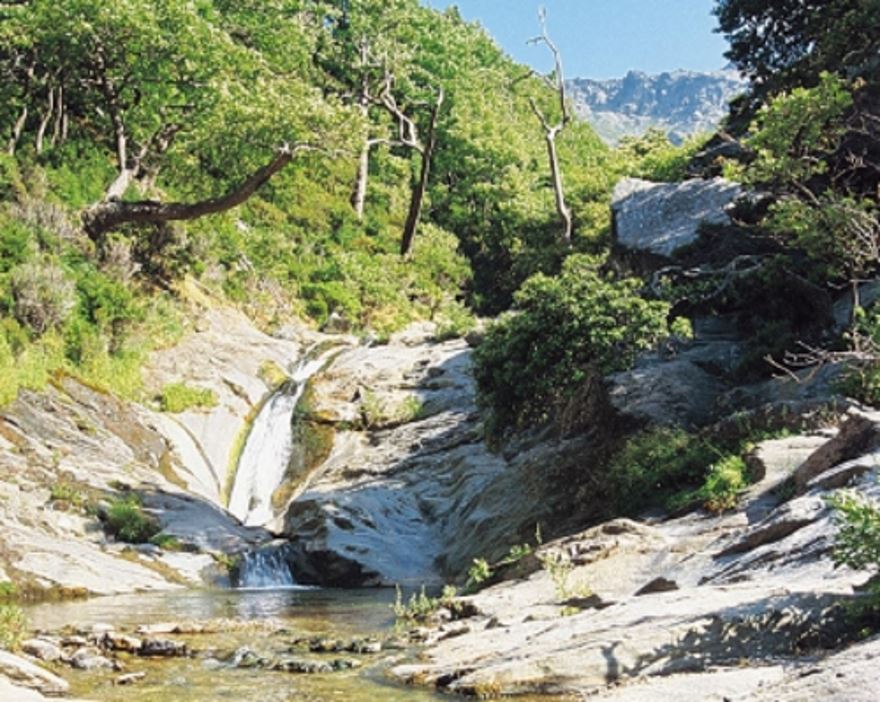"Dimossari"

It is divided into two sections - above and below the village of Lenosaioi. The section above the village is steep and wild. From the village of Lenosaioi to the sea it becomes a narrow valley. Rising above the gorge is the massif of Lakka Boukoura and its highest peak, Boublia.
The path through the gorge used to be one of the main communication routes in South Evia. it also linked the villages of Kallianou and the Cavodoro with Karystos. The stone-paved path and the remains of the cobbled track date as far back as the Middle Ages or even earlier. It could also be linked to the extraction of ore in the wider area of Kallianou.
Nowadays the path through the gorge still constitutes a passage route for the farmers and a walking destination for the ever-increasing number of hikers in the area. The most attractive and less arduous route starts from Petrokanalo Pass (954m altitude) and descends northwards. After 10 km of downhill hiking it reaches the beach of Kallianou. The trail is passable and well-marked and a great section of it is done in the shade of the plane trees. At about two-thirds of the way down, we come across the village of Lenosaioi. From that point on the route follows a dirt track for about 1.5km where we find a new path that leads to the sea and the welcoming canopy of the plane trees.
The cool microclimate of the gorge offers ideal growing conditions for a variety of forest and shrub vegetation.Higher up on the mountain, where the gorge is damper and colder, above the springs and crags of Giouda, we find thin clumps of yew, oak, maple and the odd chestnut trees. These are the remains of pre-existing extensive forest vegetation.
In the rockier and drier parts of the gorge, we find holly oak forests up to an altitude of 900metres. These forests are either single-species or mixed with plane trees, oak and heath. Characteristic of the upper section of the gorge are the clumps of perennial chestnut trees. Littoral forests with plane trees start at an altitude of 1.200m and descend all the way to the sea. At the higher altitudes of the gorge heath is the most typical shrub.
The wild and inaccessible sections of the gorge provide ideal nesting grounds for birds. Some of the most impressive species are the white throated dipper (Cinclus cinclus), the Eurasian eagle owl (Bubo bubo), the short-toed snake eagle (Circaetus gallicus), the buzzard (Buteo buteo, the sparrow hawk ( Accipiter nisus), the kestrel (Falco tinnunculus), the Bonelli eagle ( Hieraetus fasciatus), the European robin ( Erithacus rubecula), the blackbird (Turdus merula), the nightingale ( Luscinia megarhynchos), the chaffinch ( Fringilla coelebs), as well as many other common songbirds.
The reptile population of the gorge is also of great interest. There are several species of snakes, such as the water snake (Natrix natrix) which we find in great numbers in the river, Dahl's whip snake (Coluber nijadum), the four-lined snake (Elaphe quatuorlineata), the Montepellier snake (malpolon monspesulanus), the sand-viper (Vipera ammodytes), the tree-snake (Columber laurenti) and others.
The gorge of Dimossari is an ideal destination for nature lovers and for people with more specialized interests: dozens of springs, waterfalls, primeval riverside forests and abundant wildlife offer the hiker a variety of fresh images.
We can provide you with more information on the gorge of Dimossari at the Karystion Hotel.










